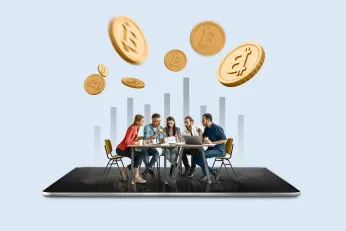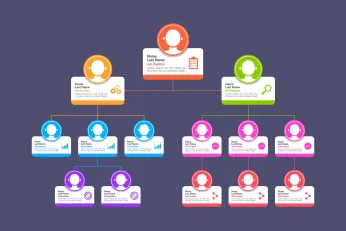On this page
You don’t need hi-research to make the connection between an intuitive incentive program and a Sales Culture that consistently creates rockstars while delivering incremental impact (yes, even in times of crisis). But if you want, it’s there. The bigger question is, what goes into the recipe of this culture? Let’s find out…
Ouch! Sales Has Changed
Sales today is no longer the ‘wham-bam-yes-I-can’ shtick it once used to be. Sure, it is still one of the most rewarding and glamorous career pursuits out there - one where we hew our own success path by dint of raw talent, dedication, and hard work. In 2021, however, space is also highly sophisticated (some prefer using the monolithic term ‘complex,’ but that misses the glorious subtleties that have made the game less predictable and more exciting), involves de-riddling several new jigsaw pieces, and doesn’t always involve a linear A-to-B type path it once used to.
Powers Shaping the New Sales Incentive Plan
Today, customers are more aware and informed, making convincing them akin to building a well structured, step-by-step dissertation or thesis that must validate every claim with cogent reasoning and real-time data. The landscape of products and services is, in itself, more complex today - and demands a certain depth of understanding and familiarity from the individual evangelizing and promoting it. Buyers in the new era need ratification from the highest authorities, which brings influencers (who are subject matter experts, no less) into the picture in an unequivocal way. And finally, purchase cycles are way longer, making forecasts and goal-planning a far dicier proposition than before.
Agile organizations have been alert to these disruptions for a while now and have been adapting (and backyard-breeding) templates and roadmaps to deal with this. Some common responses have been (A) embracing a multi-stakeholder sales cycle (team-based approach), (B) integrating digital and online channels, and (C) creating room in the loop for influencers and experts.
Decoding Change by Recoding Incentives
“Smart revisions of compensation models have been found to have a 50 percent higher impact on sales than changes in advertising investments.” McKinsey
Decoding the fast transforming scenario of Sales is imperative for businesses to survive and succeed (especially in crisis times as the current one). One of the ways to do that is to relook the incentive game. This is the bit that is often overlooked, though not by the smarter players. Creating whole new intuitive incentive models (i.e., blending salary, commissions, quotas, and bonuses in creative ways) that elicit the best out of team members, innovating behavior models that drive success on a ‘new playground’ and keeping team optimally motivated can be the X factor that drives growth in a context of uncertainty and ambiguity and helps leaders stay on top of change. And by trying different permutations and combinations of the many different variables (A/B testing mode, to borrow a term from digital marketing) that go into the making of a smart compensation and incentive plan, businesses can both decode the nature of the new reality better AND respond appropriately to consolidate competitive edge.
Incentive: The Oldest Strategy in the World
Historically, we/mankind has worked for incentive. If you go by the broader definition, we have lived by it too. Be it internal drives and passions (intrinsic motivation) or wants and desires that find moorings in social mores (extrinsic motivation). Our motivations define who we are, the hobbies we nurture, the skills we practice, the vocations we choose, and the compensations we crave. Not surprisingly, the role of incentive in the workplace has always been paramount, be it to bring the best out of teams, keep morale high, reduce churn and attract the best talent (building the employer brand), cement relationships, and ensure that the business always stays a step ahead of both the competition and the curve.
The impact of incentives, rewards, and recognition - which come in various avatars - is well documented.
- Companies worldwide spend $46 billion on employee recognition programs.
- Research from the Aberdeen Group confirms that over 50% of best-in-class companies see increased profits through the use of SPIFs (Sales Performance Incentive Funds)
- 85% of employees believe that management should provide recognition for a job well done whenever it occurs.
- 83% of organizations suffer from a lack of employee recognition.
- 69% of employees say having a wider array of benefits would increase loyalty to their employer.
- 82.39% of employees say a lack of progression would influence the decision to leave their jobs.
- Employees confess that the three most contributing factors to quitting their jobs are a lack of career advancement opportunities, low pay, and the absence of a salary pay raise.
It's Time to Re-Engineer your Sales Incentive Structure& Reward Framework in Bold New Ways
1. Redistribute the Pie
A new generation of ‘well-clued-in’ consumers means that the sales funnel must now feature more than one personae, each of whom brings a fresh argument (in line with his or her competency areas) to quell bias, address the concern, and tilt perception from a new angle. So while ‘traditional’ Sales specialists and frontline reps will continue to spearhead the sales experience and have the biggest impact in winning accounts and retaining customers, the glory won’t be theirs alone. Solution architects, technical consultants, domain specialists, UX (user experience) designers, product managers, and customer support may all have a critical say (in varying degrees) when swaying customer decisions at strategic points along the acquisition journey.
This makes the obvious case for the need to incentivize and reward the new faces. Of course, the trick here is not to make rockstars and core members of the Sales Department feel alienated or threatened in any way by the change. So while Core Sales must continue to be compensated by the classic incentive (commissions and quotas) framework, organizations now have the ‘permission’ (express mandate, if you will) to get creative while devising the compensation formats for the other set of players who enter the loop in advisory roles and arguably have a less direct bearing on revenue. This could be a flexible bonus plan that factors in multiple things such as volume and time of involvement in the Sales process, feedback from the frontline on the impact on outcomes, overall team performance, etc.
2. Split the Pudding
With Sales becoming multidisciplinary expertise resulting from a complicated product/service value and prolonged/layered buying cycles - there is often more than one member responsible for closing any given deal. This holds even if you don’t bring in the technical and advisory consultants we discussed in the previous section. The task for leaders is to lay down clear rites of engagement and processes of governance that ensure fairness. It eliminates conflict regarding allocating team members on certain accounts and deals, judging/appraising performance (vis-a-vis outcome) and parlaying disputes over an individual’s contribution.
3. Feast, Before the Feast
Given that sales cycles are getting increasingly protracted and deals are taking longer to close, leaders, need to figure out ways to maintain interest, focus, and morale in their teams. In this context, it makes sense to share a taste of the buffet before the feast officially begins. In other words, dole out pre-sale incentives and rewards before the actual closure has happened. This can be done in one of three ways:
(A) Hand out incentives mid-way basis progress up to that point, even as you hold back the lion’s share for the end. This ushers the dual benefit of keeping the momentum going with feel-good appetizers without undermining the importance of focus, tenacity, and patience, which continue to play a part in shaping the endgame.
(B) Mix up each sales member's portfolio with a judicious salad of deals and accounts with both quick AND long-drawn-out sales loops. This will ensure that the bread-and-butter keeps coming as teams stay tuned for the big prize at the end of the tunnel.
(C) Build entirely distinct/separate teams of short-cycle and long-cycle specialists, with the former having a base-pay that’s substantial enough to sustain momentum over a stretch that doesn’t feature commissions while remaining attractive enough to befit a reward for a hard-earned closure.
A hybrid and a pliant incentive-reward matrix like this can bring multiple benefits. Not only does it keep the mojo going amongst workers, but it also provides both (A) the psychological (job) security we all need to give our best every day, AND (B) the opportunity to grow laterally by occasionally trying their hand at the ‘other’ deal basket (long or shorter cycle, as applicable) which they don’t have the natural skills for.
4. Don't Steal their Cheese
The advent of digital channels - while a boon for marketing - isn’t always Sales’ best friend. The reason isn’t hard to understand. The salesperson will often put in the hard labor at the top of the acquisition funnel - be it hosting a presentation or webinar, giving an online demo, or helpfully consulting a potential client countless times before they soften - only to see the account get sucked into a digital eco-system carefully laid out by marketing. It’s akin to a curt “Thanks, buddy; I’ll take it from here” after the frontline warrior has risked life and limb to snatch the treasure from a pirate’s den. All inadvertently, of course, but the salesperson can justifiably be left nursing a hollow feeling whenever something like this happens.
To pre-empt such negativity - which can sap efficiency and sabotage the system - and, more importantly, to give credit where it’s truly due, leaders must devise a way to accurately study and measure the total involvement and cumulative influence of Sales at every point of the funnel (digital or otherwise) - and reward in ways and means that are commensurate with a contribution.
5. Make them Bake
Co-create the experience. Let the members of your sales design the journey - right from picking the deal portfolio to fixing the target to devising the timeline to yes, suggesting the incentive. As long as the overarching business purpose (and, at a more micro level, the quarterly goals) is being met, allowing teams to custom-create their own cycle can be a glorious Win-Win formula for all parties concerned. With the recipient designing his or her own reward, the otherwise tricky territory of motivation is taken care of in the most authentic sense possible. The organization is assured of optimal performance.
6. Add Salt to Taste (One Flavor won't fit All)
An organization’s Salesforce typically comprises three tiers of workers: The rockstars, the Middle, and the laggards. Each group brings its own set of motivations (be it external or internal) to the table and must be treated distinctly from the others.
Rockstars hate being reined in (especially when they ‘hot and in-form’) and can lose their fizz if incentives are capped when targets are met (a common practice), so it’s best to give your top layer a free hand. While this can mean some additional pressure on the coffers (the reason why Finance will be the first to oppose the move), the spoils will generate will more than makeup.
What about the Middle? This is a layer that features your bread-and-butter warriors - the steady, faff-free performers you can rely on to bring home the daily bacon. Statistically, this ‘Middle Earth’ of your organization is the most responsive to incentives (the more tiered/granular, the better) and opportunities for improvement and betterment. However, clubbing them in the same group as rockstars may make them feel out of their elements and cause them to ‘tune out,’ so make sure you respect them for exactly who they are – and engage them with a bespoke plan ‘at their level.’
Then there are the laggards - a motley crew of complacent veterans, unmotivated talent, and new joiners - who can still improve given the right incentive, coaching, and yes, even social / peer pressure at regular intervals (an example of the last bit is sharing performance leaderboards every week which not only nudges their ego but also helps peers to reach out to them with well-meaning advice and support). Gamification - a proven device that stokes healthy competition to keep your sales armies at the peak of their power - can be effective at all levels when wielded with tact.
7. Cash is Good, but Kind is Yummier
Explore the magic of non-monetary forms of compensation and incentive. Done every once in a while, a non-monetary reward can be warm, personal, and memorable, helping communicate vibes cash never can. For one thing, it is more visible and acts as a powerful reminder of the achievement around the year - making it a great trophy for the mantle-piece and doubling up as an ego-massager. Secondly, a non-monetary reward that is well researched to fit the persona and wish-list of the recipient conveys, in no uncertain terms, how the team has gone out of their way to find the perfect gift. By extension, the regard and respect they hold for the winner. Finally, a non-monetary compensation - such as, say, a laptop or dinner set - retains its tangible-ness / utility for a longer time in one’s life cycle and can be a more ‘efficient’ gift than moolah.
Latest digital solutions in the motivation and performance space let you make the most of this opportunity with a whole variety of non-monetary reward options straddling products, experiences, vouchers, utilities, luxuries, indulgences, accessories, branded currency, gifts and more – all of which can be seamlessly matched with performance and dispatched to the deserving candidate instantly. That last bit is critical since an incentive delayed is akin to an incentive denied. Go digital with incentives by following up the saga of guts with the moment of glory without missing a beat or breaking the winning tempo.
The Wrap, Before You Roll
The key to getting your brand new Sales incentive show on the road is to categorize/break down your employees' capabilities in different baskets and deploy different strokes for different folks.
The other important thing is to keep in mind is that change doesn’t need to be triggered organization-wide all at once. Pivot the transition patiently with ‘mini pilots’ and ‘beta versions’ around a single group at a time – be it your Rockstars, Middles, or Laggards.
Organizations must also be agile in leveraging the power of tech, digital, and analytics so that they base every decision - be it market demand, sales projections, or the team’s appetite/capability to deliver - on hard, real-time data and not just hunch (although the ‘gut feelings’ of seasoned leaders must continue to play a powerful role in decision making at all levels). Data adds the nuance, clarity, and visibility even the most innovative incentive & reward program needs to perform at peak potential.
On their part, Rewards - when they are meted out - must be (A) commensurate with the achievement, (B) resonates with the personality and Wish-Lists of the achiever, and (C) is shared instantly (in today’s world of ‘instant gratification,’ a pat-on-the-back that is delayed is pretty much a pat-on-the-back that is denied).
Finally, one must never forget that there are incentives beyond both the monetary and non-monetary kind. For example, feelings of ‘attachment’ and ‘belonging’ to the company culture, the satisfaction of a role that ‘hits the spot’ by adding a rich icing of ‘meaning’ and ‘significance’ to the daily routine, and peers/bosses one can knock back a few pints with after work (without being judged) are invisible but power-packed magnets that can often over-ride the impact of a more overt compensation package. Leaders who recognize and implement often end up reaching heights a linear incentive strategy can never take them.
Don't Just Think Sales Incentive... Rethink It.
Given that we live in an uber-VUCA world where customer behavior will keep morphing, and technological disruption will remain a fixture, Sales will have to keep reinventing itself. And the surest way to do that is to keep looking at your perks and incentive in bold, new and exciting ways. While doing so, one has to remember that carrots must not be designed in isolation. The culture of the organization, the unique personality of the performer (which can be a layered mix of intrinsic and extrinsic motivation), and the big organizational ‘WHY’ (the big mission, or raison d’etre, of the outfit) must form the sturdy bedrock for a fulfilling and purpose-first incentive program which not only brings the organization closer to its goal but binds it closer with its most important capital: people.
Motivate your sales team by recognizing their value and making them feel valued... with Compass
- ALIGN them with overarching organizational goals.
- BOOST their earning power by guiding success-habits and defining incentive-behaviors.
- INSPIRE and empower them to shine with real-time nudges, data-driven coaching, and fair appraisal + rewards.
- FIRE them up by stoking healthy competition via gamification.
- EARN their confidence by sharing full visibility of performance.
- HONOR their impact with rewards and incentives that measure up to the effort, are matched to the personality, and delivered instantly.













